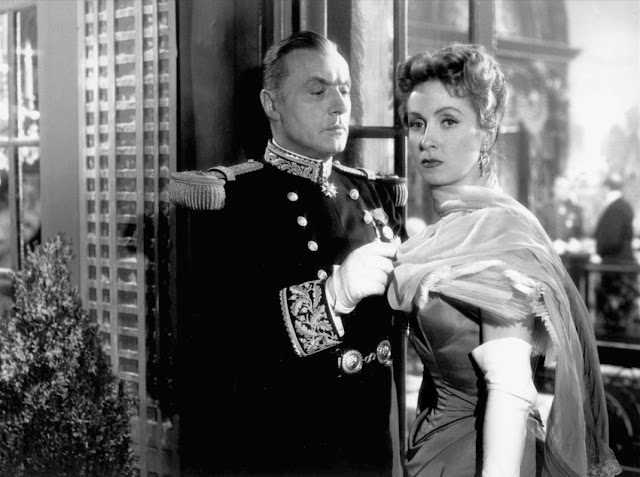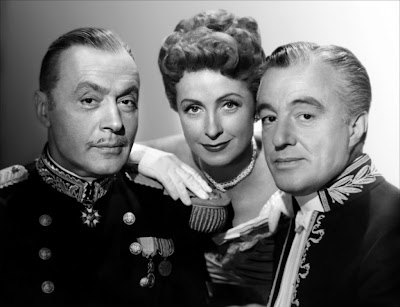 |
| Madame de.... |
‘Madame
de… was a most elegant lady, distinguished, and received everywhere. She seemed
destined to a delightful untroubled existence. Doubtless nothing would have
happened, but for the jewels’. This wee paragraph appears on screen, as the
film is about to start. The jewels in question are a pair of diamond earrings,
a wedding present from her husband Andre, which she sells without his knowledge
to cover debts she has accrued due to her lavish spending. When the jeweller
informs the General he buys them back and gives them as a farewell gift to his
mistress. She travels to Constantinople and relinquishes them to her gambling
debts. Its there that the Baron Fabrizio Donati purchases the earrings and at
the same time meets Louise, Madame de, and the pair fall dangerously in love.
Donati gives them as a present to Louise who then returns to France.
 |
| Louise and Donati. |
It’s these two pieces of jewellery that form
the substance of Max Ophuls love story. To Louise they are a token of her love
for Donati, to Andre, the General; they are a token of his possession and power
he welds over his wife. But Ophuls is not judgemental, leaving the audience to consider
the French countesses emotional journey along the diseased road that
can be love. ‘The camera exists to create
a new art – to show what can be seen elsewhere, neither in theatre nor in life’.[1]
Ophuls statement could not be truer than in Madame de… (1953) his
penultimate film before his death in 1957, one in which he directing his polished
cast with the hand of a master. The bond between him and his actors is so
obvious especially with Danielle Darrieux, the heart of the film, who plays the
frivolous Parisian woman to perfection, Charles Boyer is every inch the 19th
century French General with Vittorio De Sica portraying the suave international
Diplomat. Its also pretty obvious that Christain Matras camera work is in love
with the actors, when the couple dance, your on the dance floor breathing down
their sophisticated necks, but what makes it even more interesting is that
Matras does not rely on the obvious shot and his framing is absolutely
exceptional enticing us, the audience, in as though we are scrutinising a
painting. The whole shoot flows and ebbs like a Strauss Waltz with the director
appreciating that music plays such great part in this adaptation from Louise
Leveque de Vilmorin’s period novel. Recently released on a flawless new print that
emphasises what a true cinematic classic Max Ophuls penultimate film actually
is.


No comments:
Post a Comment